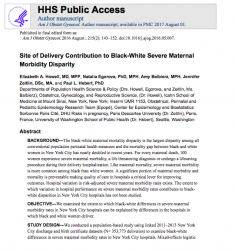You are looking at an archived version of our site. Please visit thepcc.org for a fresh, new experience!
You are here: Array » Site of delivery contr ...
Site of delivery contribution to black-white severe maternal morbidity disparity.

BACKGROUND:
The black-white maternal mortality disparity is the largest disparity among all conventional population perinatal health measures, and the mortality gap between black and white women in New York City has nearly doubled in recent years. For every maternal death, 100 women experience severe maternal morbidity, a life-threatening diagnosis, or undergo a life-saving procedure during their delivery hospitalization. Like maternal mortality, severe maternal morbidity is more common among black than white women. A significant portion of maternal morbidity and mortality is preventable, making quality of care in hospitals a critical lever for improving outcomes. Hospital variation in risk-adjusted severe maternal morbidity rates exists. The extent to which variation in hospital performance on severe maternal morbidity rates contributes to black-white disparities in New York City hospitals has not been studied.
OBJECTIVE:
We examined the extent to which black-white differences in severe maternal morbidity rates in New York City hospitals can be explained by differences in the hospitals in which black and white women deliver.
STUDY DESIGN:
We conducted a population-based study using linked 2011-2013 New York City discharge and birth certificate datasets (n = 353,773 deliveries) to examine black-white differences in severe maternal morbidity rates in New York City hospitals. A mixed-effects logistic regression with a random hospital-specific intercept was used to generate risk-standardized severe maternal morbidity rates for each hospital (n = 40). We then assessed differences in the distributions of black and white deliveries among these hospitals.
RESULTS:
Severe maternal morbidity occurred in 8882 deliveries (2.5%) and was higher among black than white women (4.2% vs 1.5%, P < .001). After adjustment for patient characteristics and comorbidities, the risk remained elevated for black women (odds ratio, 2.02; 95% confidence interval, 1.89-2.17). Risk-standardized severe maternal morbidity rates among New York City hospitals ranged from 0.8 to 5.7 per 100 deliveries. White deliveries were more likely to be delivered in low-morbidity hospitals: 65% of white vs 23% of black deliveries occurred in hospitals in the lowest tertile for morbidity. We estimated that black-white differences in delivery location may contribute as much as 47.7% of the racial disparity in severe maternal morbidity rates in New York City.
CONCLUSION:
Black mothers are more likely to deliver at higher risk-standardized severe maternal morbidity hospitals than are white mothers, contributing to black-white disparities. More research is needed to understand the attributes of high-performing hospitals and to share best practices among hospitals.
| Fichier attaché | Taille |
|---|---|
| 918.48 KB |
Full Resource/Source: Site of Delivery Contribution to Black-White Severe Maternal Morbidity Disparity
Secondary menu
Copyright © 2024 Primary Care Collaborative



